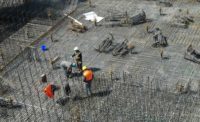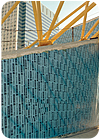
Photo
courtesy of Carlisle Coatings and Waterproofing.
When selecting a waterproofing material, conservatism is the watchword. Remember, you only have the opportunity to do this once. Proper research and due diligence is required to ensure that all waterproofing issues are properly addressed. Site-specific issues and building requirements also necessitate proper consideration. The designer must choose a material that is well suited for the long-term waterproofing needs of the building.
Selection of waterproofing materials for below-grade construction requires extensive research due to the plethora of new materials that have been developed for the waterproofing market. In the past decade, there has been an increase in the number of roofing material manufacturers selling their products as waterproofing materials. This practice can be tolerated in above-grade construction, such as plaza decks, where there exists a strong similarity to roof elements. In below-grade construction, there are several extremely different elements.
There is a misconception in architectural circles that roofing and waterproofing materials are interchangeable. This belief exists in part because the primary function of each component is to protect the structure and its interior components from moisture infiltration. Moreover, some manufacturers provide both roofing and waterproofing materials. However, there are substantial differences between the types of products that are required in each field. Materials manufactured for roofing applications will not work in below-grade waterproofing conditions without significant modifications. The reverse is also true.
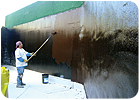
Liquid-applied Barritech VP features a simple,
single-component application by spray or roller and a quick, primerless
application over concrete block, concrete, exterior gypsum sheathing, plywood,
oriented strand board (OSB) and many other common building materials.
There are several considerations that an architect or waterproofing designer must examine prior to the selection of a waterproofing material on below-grade construction. Some of the attributes that a waterproofing material possess are:
- Resistance to hydrostatic pressure.
- Chemical resistance.
- Performance in high ground water.
- Low water absorption rate.
- Uniform thickness.
- Flexibility.
Prior to the design stage, a civil engineer should be hired to conduct site and soil tests. The tests will determine the water table level, if there is a presence of hydrostatic pressure and the chemicals found in the soil. Waterproofing materials must be able to perform in high ground water conditions and resist hydrostatic pressure. Prior to design the architect or designer should verify that the waterproofing materials submitted have passed the ASTM tests for resistance to hydrostatic pressure and performance in high ground water conditions. Materials that do not comply with these site-specific conditions should not be used in below-grade construction.
The water table level is an important consideration that determines not only the type of waterproofing required but whether waterproofing is required by code. The International Building Code requires that waterproofing or dampproofing be applied on all below-grade structures where the ground water table is maintained a minimum of 6 inches below the ground slab.
Accurate soil bearings - completed by a competent civil engineer - are required prior to waterproofing design. In the Northern Hemisphere, the water table is usually highest after the spring thaws have saturated the ground and lowest following the summer evaporation of the surface moisture. Proper waterproofing design should be based on the maximum water table level for the site.
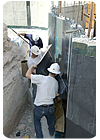
The
most common type of system used in vertical applications is reinforced sheet
membrane. (Photo courtesy of Carlisle Coatings and Waterproofing.)
Waterproofing materials are unique because they are exposed too much harsher conditions than any of the other building exterior components. Most of the exposure elements are continuously present at the waterproofing surface and do not dissipate as they do at the other exterior components. For example, water can be present in below-grade surfaces for weeks, whereas water on roof systems is to be removed within 48 hours.
It is important to consider the soil characteristics. Chemicals in the soil can have an adverse effect on some materials, and knowledge of potential chemicals present is required for design. Chemical properties in soils can adversely affect waterproofing in various ways. Acids and alkaline in ground water can accelerate the deterioration of concrete and steel reinforcing bars. Salt in water corrodes reinforcing bars in concrete. Sulfates can have a negative reaction with Portland cement, resulting in internal shearing stress that causes spalling. Other chemicals that affect waterproofing are calcium hydroxides, oils and chemicals from fertilizer.
The physical properties of the soil can also affect waterproofing. Clay soils of low permeability limit underground hydrostatic pressure. The intensity and nature of hydrostatic pressure can force water into tie-rod holes, cold joints and rock pockets. Hydrostatic pressure can also turn minor imperfections into probable sources of leaks.
Furthermore, the architect or designer should supply the waterproofing manufacturer with the soil analysis to determine if the material is resistant to the identified soil chemicals. All below-grade material manufacturers should be able to provide a detailed list of the chemicals that the material is resistant to. The architect or designer should require that the material manufacturer provide this list in written letter or report that will be placed in the project file.
Low Water Absorption Rate
The best way for a designer to determine which materials that are best suited for a waterproofing application is through the examination of each material’s physical properties. A key element of waterproofing materials is the water absorption rate. A satisfactory rate should be below 4 percent, preferably in the 1 percent to 2 percent range. Many modified bitumen materials used in roofing have water absorption rates of nearly 10 percent or higher. If these materials were exposed to the perpetually wet conditions found in waterproofing environments, there is a probability of water wicking, which could cause the membrane to swell and disbond. There are waterproofing materials on the U.S. market that have water absorption rates of zero.
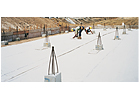
Prior
to the design stage, a civil engineer should be hired to conduct site and soil
tests. (Photo courtesy of Carlisle Coatings and Waterproofing.)
Pre-manufactured waterproofing sheets provide a distinct advantage because there is little roof for application error. Reinforced sheet membranes, because of their proven reliability over the years, are the most common type of system used in vertical applications. There are manufacturers in the United States that have supplied these systems for over 60 years.
Materials for reinforced sheet membranes are manufactured with a specially engineered polymer applied over a reinforcement to produce a membrane sheet. The sheet is applied in the manufacturer’s mastic and/or adhesive. The reinforcement of the materials used for the waterproofing barrier normally provides a uniform thickness in application. Most manufacturers will stipulate that their protective coatings are applied to the point where the weave of the fabric does not show. This provides a smooth, liquid-only appearance and provides a monolithic application with no seams.
The main advantage of these systems is that the built-in reinforcement through the use of felts and/or fabric has supplied additional forgiveness of structural movement obtained through settlement, curing of the concrete and the normal accommodations of the building to temperature differentials. This accommodation or forgiveness by the membrane helps to ensure a continuous barrier against the infiltration of water in both liquid and vapor forms.
Flexibility and Track Record
The material’s ability to resist differential movement and bridge concrete cracks is also an important attribute. The designer or architect should confirm that the materials tensile and elongation rates are in compliance with industry standards.
Another important aspect of material choice is the reliability of the waterproofing product and the material manufacturer. Remember that as a designer, you get only one chance to do this right. One simple way to evaluate a product is to check its track record in similar waterproofing applications. Sources of information could include other designers, building owners, contractors or specialty consultants.
It could also be beneficial to ask specific questions of the manufacturers. The first question should be whether the product is manufactured by the seller or if the seller is merely a distributor (by private label agreement). This is very common in the construction materials industry. Manufacturers typically private label some - or all - of the system components. This type of information is available through Dun & Bradstreet.
If you talk to other industry professionals or manufacturers, it would also be important to find out if the product has a history of successful performance under comparable conditions for at least 15 to 20 years. Obviously, if the product has not performed in the past it is safe to assume it will have the same difficulties on your project. Designers should also be skeptical of other building component materials being marketed for waterproofing applications without a track record in similar conditions. No other building component is exposed to the conditions of waterproofing materials.
Another important consideration is whether the material has maintained a consistent formulation for the past 10 years. This is a significant concern at this time. Environmental regulations and depletion of natural resources have had a large impact on current material formulations. Products that we have relied on for hundreds of years are not as readily available. This has left the industry with some new formulations with no verifiable track record.



